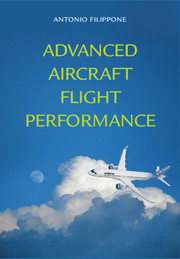Book contents
- Frontmatter
- Contents
- Tables
- Preface
- Nomenclature
- Technology Warning
- 1 Prolegomena
- 2 Aircraft Models
- 3 Weight and Balance Performance
- 4 Aerodynamic Performance
- 5 Engine Performance
- 6 Propeller Performance
- 7 Airplane Trim
- 8 Flight Envelopes
- 9 Take-Off and Field Performance
- 10 Climb Performance
- 11 Descent and Landing Performance
- 12 Cruise Performance
- 13 Manoeuvre Performance
- 14 Thermo-Structural Performance
- 15 Mission Analysis
- 16 Aircraft Noise: Noise Sources
- 17 Aircraft Noise: Propagation
- 18 Aircraft Noise: Flight Trajectories
- 19 Environmental Performance
- 20 Epilogue
- Appendix A Gulfstream G-550
- Appendix B Certified Aircraft Noise Data
- Appendix C Options for the FLIGHT Program
- Index
- References
4 - Aerodynamic Performance
Published online by Cambridge University Press: 05 January 2013
- Frontmatter
- Contents
- Tables
- Preface
- Nomenclature
- Technology Warning
- 1 Prolegomena
- 2 Aircraft Models
- 3 Weight and Balance Performance
- 4 Aerodynamic Performance
- 5 Engine Performance
- 6 Propeller Performance
- 7 Airplane Trim
- 8 Flight Envelopes
- 9 Take-Off and Field Performance
- 10 Climb Performance
- 11 Descent and Landing Performance
- 12 Cruise Performance
- 13 Manoeuvre Performance
- 14 Thermo-Structural Performance
- 15 Mission Analysis
- 16 Aircraft Noise: Noise Sources
- 17 Aircraft Noise: Propagation
- 18 Aircraft Noise: Flight Trajectories
- 19 Environmental Performance
- 20 Epilogue
- Appendix A Gulfstream G-550
- Appendix B Certified Aircraft Noise Data
- Appendix C Options for the FLIGHT Program
- Index
- References
Summary
Overview
In this chapter, we present first-order methods, based on the principle of components, to determine the aerodynamic properties of the aircraft. One is tempted to develop methods of high accuracy, based on the physics. These methods are inevitably complex and computer intensive. The requirement for methods of general value inevitably limits the accuracy on any single aircraft. Aerodynamic data of real airplanes are closely guarded. We show how these low-order methods, with a compromise between physics and empiricism, yield results of acceptable accuracy.
We deal with aerodynamic lift in § 4.1. The wide subject of aerodynamic drag (§ 4.2) is split into several sub-sections that present practical methods. The analysis of the aerodynamic drag has a number of separate items, including a transonic model for wing sections (§ 4.3) to be used in the propeller model (Chapter 6), transonic and supersonic drag of wing-body combinations and bodies of revolution (§ 4.4), and buffet boundaries (§ 4.5). We present a short discussion on the aerodynamic derivatives in § 4.6. We expand the aerodynamic analysis to the estimation of the drag of a float-plane in § 4.7. We finish this chapter with a simple analysis of the vortex wakes and the aircraft separation distance (§ 4.8).
KEY CONCEPTS: Aircraft Lift, Aircraft Drag, Transonic Drag Rise, Supersonic Drag, Bodies of Revolution, Buffet Boundaries, Aerodynamic Derivatives, Float-Planes.
Aircraft Lift
The determination of the lift characteristics of the wing ultimately depends on the amount of information that is available. Often only the plan form shape is known.
- Type
- Chapter
- Information
- Advanced Aircraft Flight Performance , pp. 78 - 125Publisher: Cambridge University PressPrint publication year: 2012



